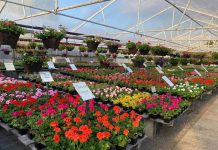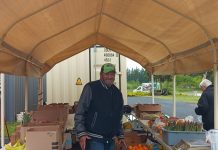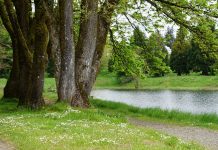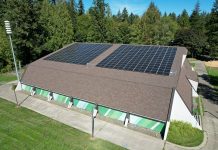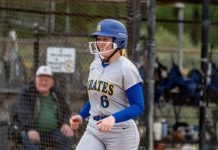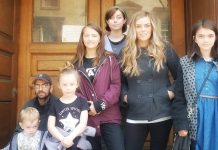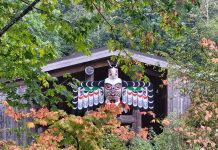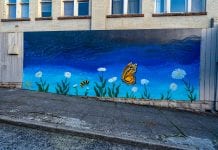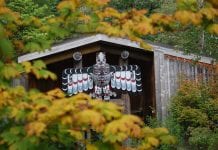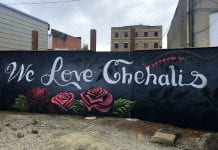A walk through the Borst House Museum complex is a time-traveling experience. The house (built in 1864), school and even the little graveyard are lovingly maintained, but what brings these beautiful historic buildings to the next level are the gardens situated amongst them.
The WSU Lewis County Master Gardeners are the ones behind these charming gardens. Every Wednesday and Saturday morning the group gathers in the gardens to weed, water and support each other’s efforts.
The primary purpose of the Borst House Demonstration Gardens is education, but a pleasant side effect is wonder, inspiration and curiosity as each little garden tells a story. According to Jan Sparks, their energetic coordinator, the goal is to educate the public about the past, present and future of gardening.

There are at least 12 themed miniature gardens in addition to the entrance landscaping. Each theme serves a purpose. For example, the Heirloom Garden – one of the larger and most historically relevant plots – is laid out like the garden may have been when the Borst family called the area home in the Victorian Era. Items grown in the plot are from seeds that were in use in the 19th century.
The Dyers Garden also educates about the past and contains plants that are used to naturally dye materials like wool.
The Herb Garden contains classic herbs that are useful for both culinary and medicinal purposes.
“The present is teaching,” says Jan. “We teach people how to grow dahlias. We teach how to pollinate and save seeds.”

Last year the group hosted eight gardening workshops, but this summer only three are planned.
“We decided to take some time this year and regroup,” explains Jan. “We had lost some people due to health issues. So next year we should have a whole bunch of workshops.”
Other contemporary themes are the Cutting Garden, grown for flower bouquets; the Big Foot Garden which grows super-sized veggies (eight-pound tomato anyone?); the Pollinator Garden which grows flowers attractive to bees; and the Winter Garden which offers color in even in the darkest months. The Dahlia Garden is a teaching garden and is part of the Master Gardeners workshop series. The Berry Garden is laden with fruit including varieties one might not think to plant in our region, like hardy kiwis.

What will gardens look like in the future? Perhaps like the Square Foot, Native and Drought Gardens. The Square Foot Garden has, in previous years, featured vegetables but is planted with flowers this year. This gardening method is about producing and rotating a variety of plants in a small area and is workable for small yards or patios. The Native Garden showcases plants indigenous to Western Washington, which are naturally drought tolerant. The Drought Garden features grasses, stonecrops and plants that are not necessarily native to our region yet require little water. If space and water become scarce in the future, it’s reassuring that gardens are still possible. Jan points out that gardening in times of drought are also a nod to the past.
Each little garden is lovingly maintained by volunteers from the Master Gardeners. A Master Gardener is assigned a plot to cultivate and maintain. However, the group is not territorial; if one member needs help, the others are happy to pitch in.

“We help each other,” says Jan. “We are a family and we help each other all the time.”
The beauty of a garden is that it’s always changing. So, even if you’ve seen the gardens once, it’s worth the trip to see them now. Since 2016, The Arboretum has undergone annual cleanups which have opened the area up to picnickers. While cleaning up blackberries behind one of the facilities, a series of picnic benches were unearthed creating a new seating area.
If you’re interested in becoming a Master Gardener, contact the WSU Lewis County Extension Office or call 360-740-1216. You can start the program any time of year and typically it takes 12 months to complete.
There are other educational opportunities through the WSU Extension at Borst Park like the aforementioned gardening workshops. The Master Recyclers/Composters workshops cover topics like composting and mending clothing. There’s also a workshop series for food preservers.
Jan is also getting involved with the younger generation through a 4H group to be called “The Recyclables.” The goal is to teach skills at a young age like how to garden, sew, mend, recycle items and about plant sciences and woodworking.
“We’ll take some things out of the garden and make jellies to enter in the fair,” says Jan. “So kids can learn how to be part of the community, and that nothing is just instantaneous but you nurture and take care of it, just like we do with people.”
Learn about upcoming workshops at Borst Park by visiting the Lewis County Master Gardeners’ webpage and following them on Facebook.



